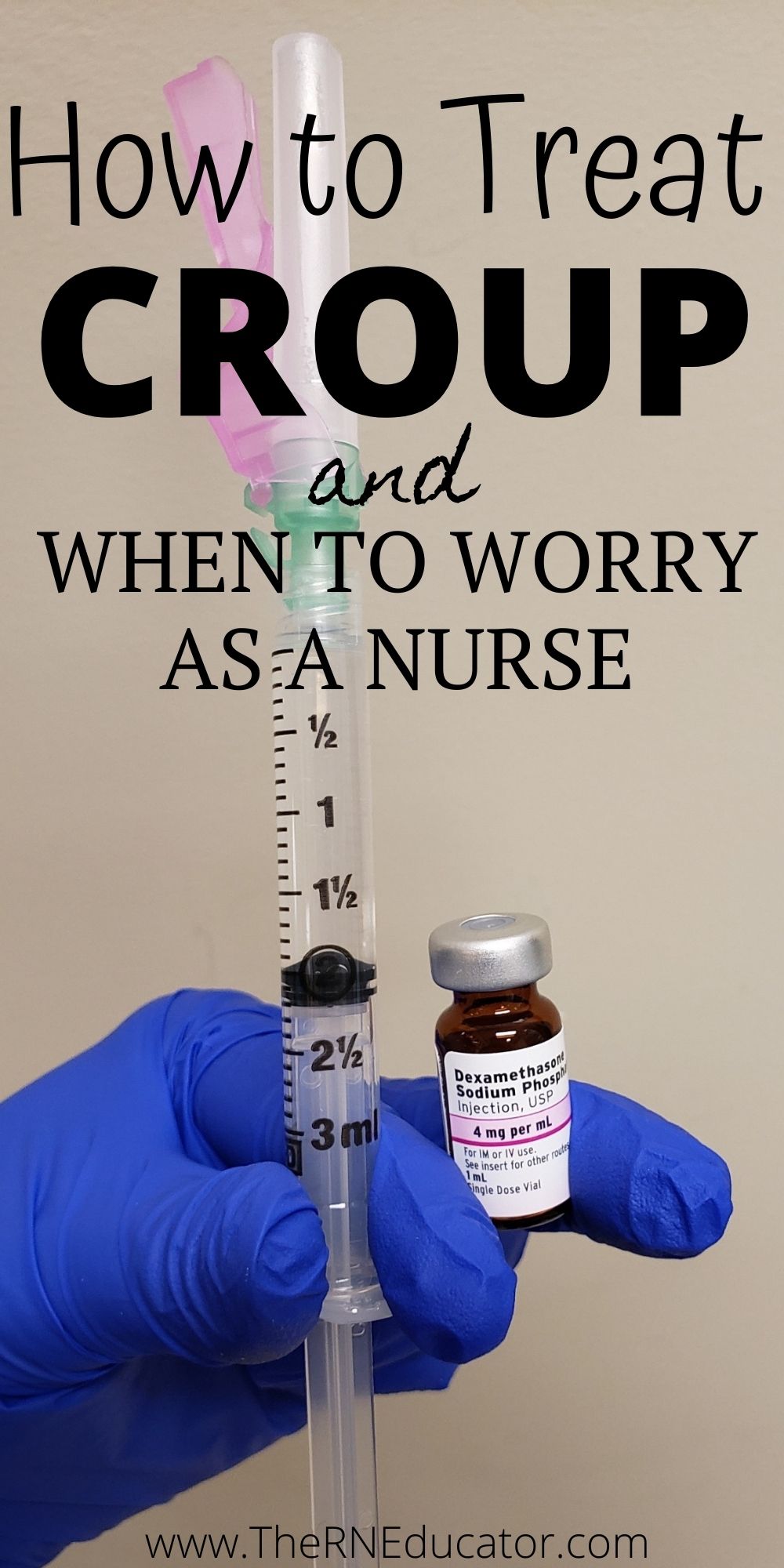How to Treat Croup and When to Worry as a Nurse

Hello, hello my nursing friends! Welcome back to class. Today we are talking about a virus that can not only be detrimental to your patients health but requires some pretty unique interventions. Ever heard of Acute Croup, a.k.a Acute Laryngotracheobronchitis? Ever wonder its signs and symptoms and how to treat croup? Well, today we will be reviewing what causes Croup, it’s clinical manifestations, some unique nursing interventions and more importantly, the big question, how to treat croup. Let’s jump into it.
What is Croup?
Croup is a viral illness that can be a result from causative agents such as RSV, Influenza A & B, Mycoplasma Pneumonia, Parainfluenza, and Measles. Also known as Laryngotracheobronchitis, Croup is a condition in which laryngeal tracheal edema, exudate and destruction of respiratory cilia can occur leading to severe respiratory distress and potential obstruction.
First – let’s break down its name to help remember what Croup really is. Many providers just call this virus CROUP so always remember it this way but it is important to understand what systems are involved in this illness to remember it’s nursing interventions.
Laryngo-tracheal-bronchitis
Laryngo = laryngeal
Tracheal = trachea
Bronchi= bronchioles
itis= inflammation
Signs and Symptoms
So, now that we know what Croup actually is let’s review what signs and symptoms we would expect to see in croup.
- low- grade fever – this viral illness is caused by a foreign agent which means there will be an immune response.
- restlessness
- barking cough – this is a UNIQUE and tell tale sign of croup.
- dyspnea – due to respiratory edema and constriction patient can develop difficulty breathing
- retractions – occurs when edema worsens and dyspnea progresses. This includes use of accessory muscles and nasal flaring (more commonly seen in infants and considered severe respiratory distress)
- inspiratory stridor – inspiratory stridor is the adventitious breath sound you hear when tracheal edema progresses and worsens as obstruction begins to occur.
I want to talk about inspiratory stridor for a second. There are two types of inspiratory stridor you need to know about as a nurse. They both will indicate a severity mark in your patients illness.
AGGRAVATED Inspiratory stridor: This stridor is not present at rest but instead is evident and audible while the child is aggravated (i.e., when the child is crying or screaming). You want to make sure you keep the child as calm as possible to avoid this type of stridor.
Inspiratory stridor AT REST: Inspiratory stridor at rest is a severe case of Croup. If your patient is having inspiratory stridor at rest you need to call the physician immediately because this patient’s airway is closing and more than likely has partial obstruction. This patient will require further nursing interventions and the need for observation.
Nursing Interventions
Starting from the least to most invasive let’s talk nursing interventions for Croup.
Monitor and observe your patient.
Monitoring and observing your patient is crucial when they are having a croup attack. This is because a patient with croup can worsen by the minute. You must monitor continuous oxygen saturation levels and respiratory status. Therefore, auscultating lung sounds, assessing for retractions (which means taking off the infant’s onesie or lifting the older child’s shirt to truly inspect their chest rise and fall and assess for any retractions is important).
You’re also looking at the patient and their appearance. Do they look tired and exhausted? Are they slouching over in tripods position? Are they having nasal flaring? Very important assessments to obtain frequently. If any of these are present your patient is in respiratory distress.
Promote rest.
Promoting rest for your patient is key in any illness. Not only does it give the body a chance to recover and heal but it also relaxes the trachea preventing laryngeal spasms or inspiratory stridor.
Steamy mist.
This is an essential part of discharge home care teaching. Use of a cool humidifier to provide a steamy mist for the child with croup has shown to vasoconstrict and help relax the laryngeal muscles.
If a parent does not have a humidifier at home they can sit in the bathroom with a warm shower running which will create a steamy shower. The key here is the humidified, moist steam which helps relieve the child’s symptoms.
However, it is important to always educate the parent if symptoms progress or worsen they must seek medical care immediately.
Treatment
Administer corticosteroids
Corticosteroids are the first step of treatment for Croup when it comes to medication. Usually a corticosteroid such as Dexamethasone (Decadron) is given either PO (if the child can tolerate oral liquids and if they are not in respiratory distress) or IM. Dexamethasone helps reduce edema in the airway and slow the destruction of respiratory cilia.
Remember, you don’t want to aggravate the child with an IM injection if it is not necessary (in other words if they can tolerate PO) but the respiratory system is the priority. If the child is breathing fast, severe cough is present, and having retractions or stridor you more than likely will be giving an IM injection to avoid any risk of aspiration.
Provide Oxygen as needed
If oxygen saturations are impacted you may see an order for supplemental oxygen to prevent hypoxia. Remember, any patient receiving oxygen should be placed on a cardiorespiratory monitor and vital signs need to be monitored.
Administer Racemic Epinephrine Nebulizer
Racemic Epinephrine is a nebulizer that provides aerosolized epinephrine. This medication acts as a vasodilator to the airway but on the other hand vasoconstricts the blood vessels. Because of this, any patient receiving Racemic Epi must be monitored with a cardic monitor for at least 4 hours to ensure there is no changes in vital signs as well as rebound of croup symptoms.
As the nurse, you will be monitoring all of this patient’s vital signs. Any form of Epinephrine may cause changes to both cardiac and respiratory system. Monitoring the heart rate, heart rhythm & blood pressure is extremely important but also observing respiratory status including respiratory rate and oxygen saturation is key.
Administer IV fluids.
IV fluids help the child with croup stay hydrated and reverse any dehydration that may have occurred. It also allows the child to remain NPO in order to decrease risk of vomiting or aspiration while the child is coughing or in any distress.
Again, you don’t want to aggravate the child more than you have to so PIV’s are usually ordered if the child isn’t doing well or the provider projects the child to get worse.
Keep patient NPO.
Keeping the patient NPO might be an order you see when the child is having respiratory distress. As mentioned before, this is mainly to prevent any risk of aspiration or vomiting which can further lead to dehydration.
Now that you know how to treat Croup, it’s signs and symptoms and unique clinical manifestations and nursing interventions, answer this:
A patient has arrived to the Emergency Department with a croupy cough and low-grade fever of 100.8. The father has not given any medication and states the symptoms started a few hours ago.
Upon your assessment, the child is calm, lung sounds are clear and patient is in no apparent distress. What do you expect the doctor to order?
’till next time,
The RN Educator
Share this:
Related Posts
What’s in a Pediatric Crash Cart? Nursing Students read NOW!
A pediatric crash cart is a mobile unit containing essential equipment and medications required for…
Share this:
How to Become a Confident Nurse
If you are anything like me, and let’s face it (like every nurse…



